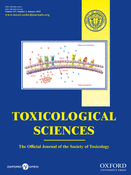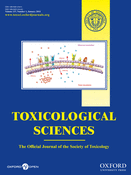
Volume 137, Issue 1
January 2014
Cover image

Cover image

Cover illustration. Grains are commonly contaminated with T-2 mycotoxins, which are known to exert developmental toxicity. In the paper by Wang et al., (page 168) the authors describe the role of various transporters in the movement of the toxin and its major metabolite across the placental barrier.
ISSN 1096-6080
EISSN 1096-0929
Issue navigation
Volume 137, Issue 1, January 2014
EDITORIAL
The Nature of Nurture: Refining the Definition of the Exposome
Gary W. Miller and Dean P. Jones
Toxicological Sciences, Volume 137, Issue 1, January 2014, Pages 1–2, https://doi.org/10.1093/toxsci/kft251
FORUM
Cumulative Risk: Toxicity and Interactions of Physical and Chemical Stressors
Cynthia V. Rider and others
Toxicological Sciences, Volume 137, Issue 1, January 2014, Pages 3–11, https://doi.org/10.1093/toxsci/kft228
BIOMARKERS OF TOXICITY
Evaluation of Serum Bile Acid Profiles as Biomarkers of Liver Injury in Rodents
Lina Luo and others
Toxicological Sciences, Volume 137, Issue 1, January 2014, Pages 12–25, https://doi.org/10.1093/toxsci/kft221
The Adaptive Endoplasmic Reticulum Stress Response to Lipotoxicity in Progressive Human Nonalcoholic Fatty Liver Disease
April D. Lake and others
Toxicological Sciences, Volume 137, Issue 1, January 2014, Pages 26–35, https://doi.org/10.1093/toxsci/kft230
CARCINOGENICITY
Characterization of Intracellular Inclusions in the Urothelium of Mice Exposed to Inorganic Arsenic
Puttappa R. Dodmane and others
Toxicological Sciences, Volume 137, Issue 1, January 2014, Pages 36–46, https://doi.org/10.1093/toxsci/kft227
Aberrant Methylation of Hypermethylated-in-Cancer-1 and Exocyclic DNA Adducts in Tobacco Smokers
Marco E. M. Peluso and others
Toxicological Sciences, Volume 137, Issue 1, January 2014, Pages 47–54, https://doi.org/10.1093/toxsci/kft241
IN VITRO METHODS AND ALTERNATIVES TO ANIMALS
A Comparative Study of Different In Vitro Lung Cell Culture Systems to Assess the Most Beneficial Tool for Screening the Potential Adverse Effects of Carbon Nanotubes
Martin J. D. Clift and others
Toxicological Sciences, Volume 137, Issue 1, January 2014, Pages 55–64, https://doi.org/10.1093/toxsci/kft216
A Combination of Pterostilbene With Autophagy Inhibitors Exerts Efficient Apoptotic Characteristics in Both Chemosensitive and Chemoresistant Lung Cancer Cells
Ming-Ju Hsieh and others
Toxicological Sciences, Volume 137, Issue 1, January 2014, Pages 65–75, https://doi.org/10.1093/toxsci/kft238
A High-Throughput Screen for Teratogens Using Human Pluripotent Stem Cells
Sei Kameoka and others
Toxicological Sciences, Volume 137, Issue 1, January 2014, Pages 76–90, https://doi.org/10.1093/toxsci/kft239
MOLECULAR TOXICOLOGY
Molecular Mechanisms of Hepatocellular Apoptosis Induced by Trovafloxacin-Tumor Necrosis Factor-alpha Interaction
Kevin M. Beggs and others
Toxicological Sciences, Volume 137, Issue 1, January 2014, Pages 91–101, https://doi.org/10.1093/toxsci/kft226
Nucleotide Specificity of DNA Binding of the Aryl Hydrocarbon Receptor:ARNT Complex Is Unaffected by Ligand Structure
Danica E. DeGroot and Michael S. Denison
Toxicological Sciences, Volume 137, Issue 1, January 2014, Pages 102–113, https://doi.org/10.1093/toxsci/kft234
Aryl Hydrocarbon Receptor–Dependent Induction of Liver Fibrosis by Dioxin
Stéphane Pierre and others
Toxicological Sciences, Volume 137, Issue 1, January 2014, Pages 114–124, https://doi.org/10.1093/toxsci/kft236
NANOTOXICOLOGY
Tungsten Carbide-Cobalt as a Nanoparticulate Reference Positive Control in In Vitro Genotoxicity Assays
Hélène Moche and others
Toxicological Sciences, Volume 137, Issue 1, January 2014, Pages 125–134, https://doi.org/10.1093/toxsci/kft222
NEUROTOXICOLOGY
ORX Neuroreceptor System and HSP90 Are Linked to Recovery Strategies Against Copper Toxicity in Thalassoma pavo
Merylin Zizza and others
Toxicological Sciences, Volume 137, Issue 1, January 2014, Pages 135–146, https://doi.org/10.1093/toxsci/kft229
Brainstem Structures Are Primarily Affected in an Experimental Model of Severe Scorpion Envenomation
Patrícia Alves Maia Guidine and others
Toxicological Sciences, Volume 137, Issue 1, January 2014, Pages 147–157, https://doi.org/10.1093/toxsci/kft231
3,3′-Diindolylmethane Inhibits Lipopolysaccharide-Induced Microglial Hyperactivation and Attenuates Brain Inflammation
Hyo Won Kim and others
Toxicological Sciences, Volume 137, Issue 1, January 2014, Pages 158–167, https://doi.org/10.1093/toxsci/kft240
REPRODUCTIVE AND DEVELOPMENTAL TOXICOLOGY
High Risk of Embryo-Fetal Toxicity: Placental Transfer of T-2 Toxin and Its Major Metabolite HT-2 Toxin in BeWo Cells
Xu Wang and others
Toxicological Sciences, Volume 137, Issue 1, January 2014, Pages 168–178, https://doi.org/10.1093/toxsci/kft233
RESPIRATORY TOXICOLOGY
Pulmonary Toxicity of Perfluorinated Silane-Based Nanofilm Spray Products: Solvent Dependency
Asger W. Nørgaard and others
Toxicological Sciences, Volume 137, Issue 1, January 2014, Pages 179–188, https://doi.org/10.1093/toxsci/kft225
SAFETY EVALUATION
A Correlation Between the In Vitro Drug Toxicity of Drugs to Cell Lines That Express Human P450s and Their Propensity to Cause Liver Injury in Humans
Frida Gustafsson and others
Toxicological Sciences, Volume 137, Issue 1, January 2014, Pages 189–211, https://doi.org/10.1093/toxsci/kft223
Multidimensional In Vivo Hazard Assessment Using Zebrafish
Lisa Truong and others
Toxicological Sciences, Volume 137, Issue 1, January 2014, Pages 212–233, https://doi.org/10.1093/toxsci/kft235
Editor’s Highlight: The Tanguay group uses the embryonic zebrafish model to demonstrate the utility of high throughput screening for toxicology studies. The group evaluated the 1060 US EPA ToxCast Phase 1 and 2 compounds on 18 distinct outcomes. With four doses for each compound the group generated a dizzying number of data points highlighting the importance of bioinformatics analysis in these types of studies. The study shows how it is now possible to screen many of the tens of thousands of untested chemicals using a whole animal model in which one can literally see developmental malformations. —Gary W. Miller
SYSTEMS TOXICOLOGY
Utilization of Causal Reasoning of Hepatic Gene Expression in Rats to Identify Molecular Pathways of Idiosyncratic Drug-Induced Liver Injury
Daphna Laifenfeld and others
Toxicological Sciences, Volume 137, Issue 1, January 2014, Pages 234–248, https://doi.org/10.1093/toxsci/kft232
E2012-Induced Cataract and Its Predictive Biomarkers
Kyoko Nakano-Ito and others
Toxicological Sciences, Volume 137, Issue 1, January 2014, Pages 249–258, https://doi.org/10.1093/toxsci/kft224
TRANSLATIONAL RESEARCH IN TOXICOLOGY
Characterization of Vemurafenib Phototoxicity in a Mouse Model
Stéphanie Marie Boudon and others
Toxicological Sciences, Volume 137, Issue 1, January 2014, Pages 259–267, https://doi.org/10.1093/toxsci/kft237
COVER
Cover
Toxicological Sciences, Volume 137, Issue 1, January 2014, Page NP, https://doi.org/10.1093/toxsci/kft279
STANDING MATERIAL
Editorial_Board
Toxicological Sciences, Volume 137, Issue 1, January 2014, Page NP, https://doi.org/10.1093/toxsci/kft280
Subscriptions
Toxicological Sciences, Volume 137, Issue 1, January 2014, Page NP, https://doi.org/10.1093/toxsci/kft281
Table_of_Contents
Toxicological Sciences, Volume 137, Issue 1, January 2014, Page NP, https://doi.org/10.1093/toxsci/kft282
Advertisement
Advertisement


